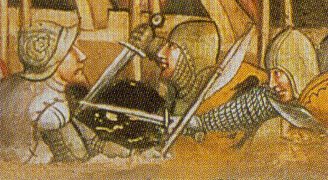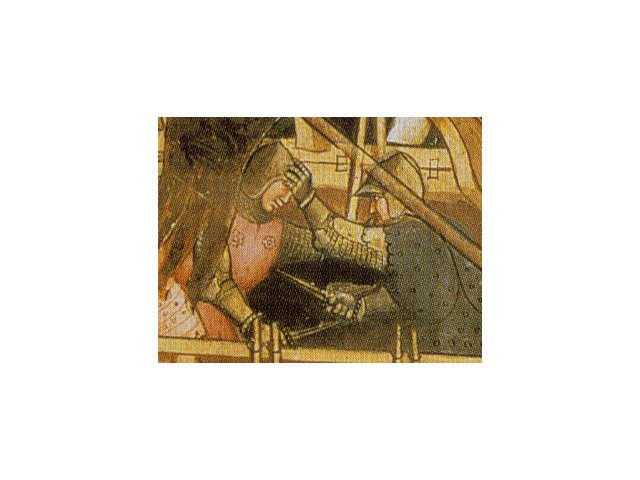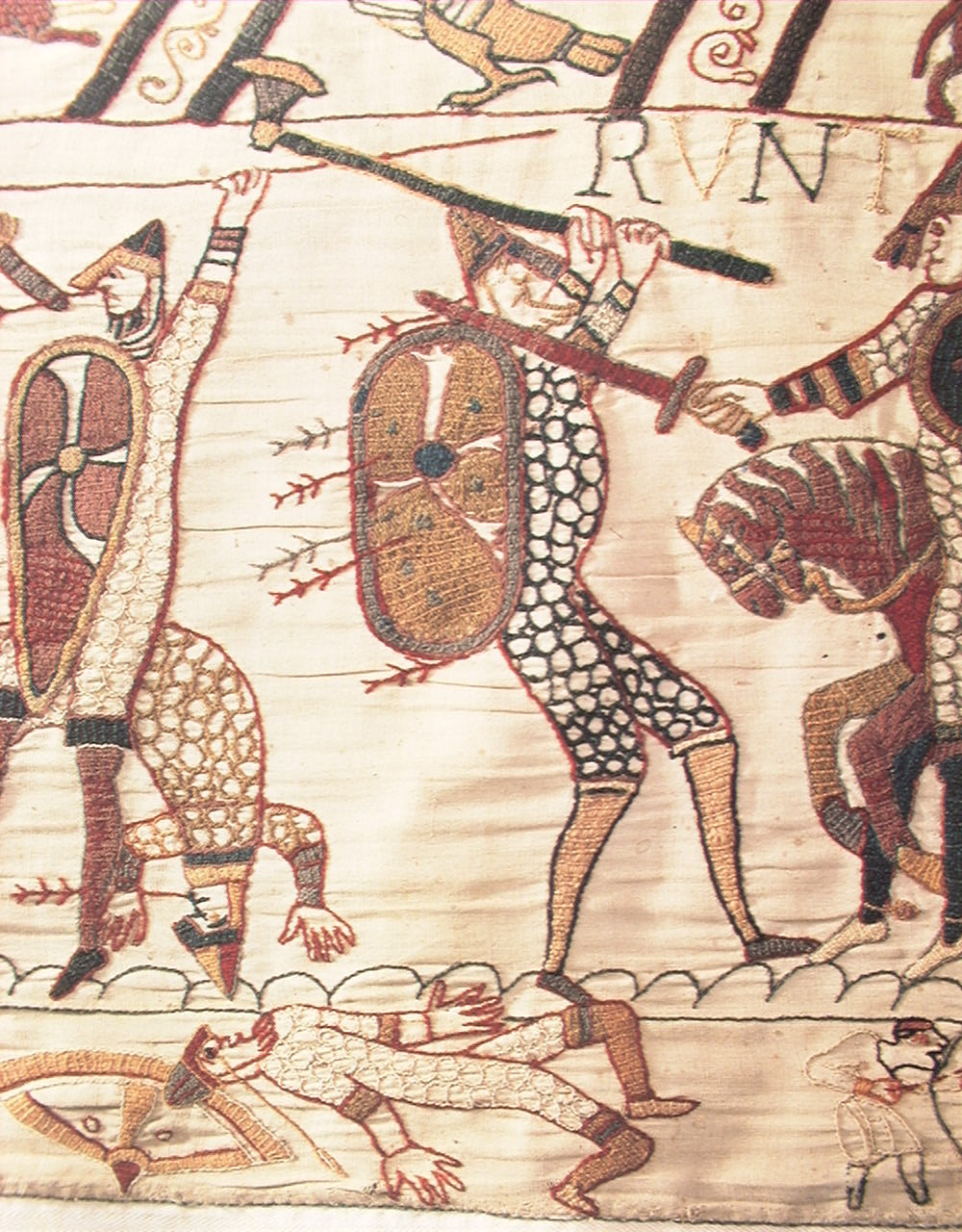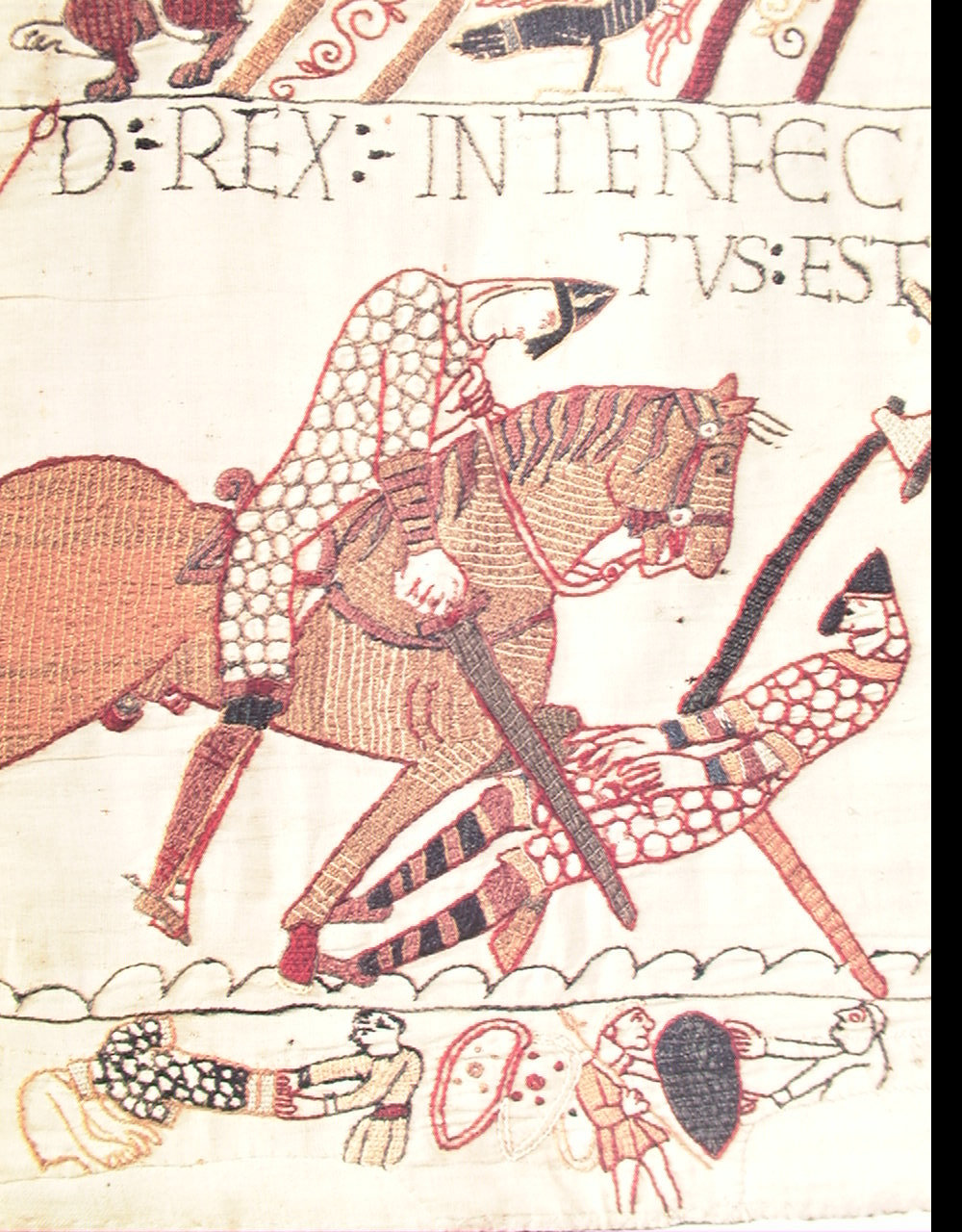| Author |
Message |
Jack Savante

|
 Posted: Sat 03 Nov, 2012 6:42 am Post subject: Is the 'handshake grip' a modern construction? Posted: Sat 03 Nov, 2012 6:42 am Post subject: Is the 'handshake grip' a modern construction? |
 |
|
Don Pentecost, author of the feather ruffling but extremely helpful and realistic 'Put 'em down, Take 'em out - Knife fighting lessons from Fulsom Prison' makes an excellent point in his diagrams of proper knife grip: hold the knife in your hand with the thumb around it tightly. But it is possible to overlook this critical and fundamental principle if one comes to learn knife fighting without correct instruction, or is self taught, particularly after a lifetime prior of using knives to cut steak.
It is easy to apply modern thinking to ancient things, and this brings me to my question. The handshake grip seems to me a modern construction. I cannot find a medieval example of it, and in the classical world it certainly is not represented in bas relief or otherwise to the best of my knowlege. The fingering of crossguards is a similar grip to the 'handshake grip' but is markedly different, and as I found out, having almost lost the top of my finger to using this technique, a very bad idea unless the sword you are using has a complex hilt!
When I first began learning how to fight with a sword I had a sword placed in my hand and the first thing I did, like they do in movies, is flourish (spin) it. I did this with finger and thumb like they do in movies. My instructor explained to me that it is very easy to knock a sword out of hand that is clasping a sword with only two digits. He was right. I believe the same principle is at work with the introduction into the collective academic mind of the sword student in respect to the handshake grip. It is a counterproductive configuration borne out of misunderstanding.
There is no doubt that life was rougher and more physical 500 or 1500 years ago. While holding a viking sword firmly without a limp wrist might be a little painful at first, if one is to do this repeatedly, it no longer hurts so much, and the guard and pommel remind us of correct hand / arm posture. While this might seem counter intuitive at first, in the modern world of comfort and ease we live in, I believe we fail to grasp that the viking sword was developed in a world far harsher and less comfortable than ours. Having a sword firmly locked in one's hand in the Migration Era could mean the difference between life and death, and discomfort is always preferable to death.
These are my thoughts on the matter, and I will happily conclude that I may be wrong. I would be interested to hear my peers thoughts on the subject, contributions of images and excerpts from relevant manuscripts of the period etc.
|
|
  |
 |
Chad Arnow
myArmoury Team


|
 Posted: Sat 03 Nov, 2012 7:02 am Post subject: Posted: Sat 03 Nov, 2012 7:02 am Post subject: |
 |
|
Jack,
Have you checked out this thread: Gripping and using a Viking sword ? Lots of good info there.
It references the Bayeux Tapestry as a source for this kind of grip. And there are others.
The handshake grip is far from limp or insecure. It's a way of holding something firmly without locking your wrist and allows natural body mechanics to aid you. It also isn't the only grip a fighter should know.

ChadA
http://chadarnow.com/
|
|
    |
 |
Jack Savante

|
|
  |
 |
Michael Curl

Location: Northern California, US Joined: 06 Jan 2008
Posts: 487
|
 Posted: Sat 03 Nov, 2012 8:37 am Post subject: Posted: Sat 03 Nov, 2012 8:37 am Post subject: |
 |
|
I am going to disagree with you sir. I have always found that a really 'strong' grip is a weak one as, at least in longsword, it limits your range of motion. A softer grip allows for a wide range of motion, this is crucial in case of a beat, which with a 'strong grip' will move your hands out of place and leave you exposed to a cut to the head. However a softer grip will allow your hands to stay in place while only the sword is moved, allowing you to counter with a krumphau.
E Pluribus Unum
|
|
   |
 |
|
Matthew P. Adams
|
 Posted: Sat 03 Nov, 2012 8:52 am Post subject: Posted: Sat 03 Nov, 2012 8:52 am Post subject: |
 |
|
The treatises show a handshake grip. Not always, but it is definitely shown in Fiore's flower of battle. The "correct" way to hold a tool is determined by what you want to do with it. When fighting against a single skilled apponent a lighter handshake grip allows you to feel your opponents blade, whether he is relaxed and confident, or nervous and tight. In a battle field situation you might prefer a hammer grip, in the chaos of the press, sensitivity could come second to security. Most questions about combat, weapon design, technique, etc. are answered with "depends". Ultimately your goal isn't "am I holding this sword correctly?" But "Have I survived this fight?" If you aren't dead, you've done it the right way.
"We do not rise to the level of our expectations. We fall to the level of our training" Archilochus, Greek Soldier, Poet, c. 650 BC
|
|
  |
 |
|
Tim Lison
|
 Posted: Sat 03 Nov, 2012 9:12 am Post subject: Posted: Sat 03 Nov, 2012 9:12 am Post subject: |
 |
|
| Matthew P. Adams wrote: | | Most questions about combat, weapon design, technique, etc. are answered with "depends". Ultimately your goal isn't "am I holding this sword correctly?" But "Have I survived this fight?" If you aren't dead, you've done it the right way. |
I think this is the most sensible way to look at any sort of combat. Both grips have their uses. The "hammer" grip would be great when in a shieldwall where smaller slashing moves would be more common, but given some space the "handshake" grip provides for more power and better control. I doubt people who truly depended on their swords to defend their lives really cared quite so much about "the proper grip".
|
|
  |
 |
|
Peter Messent
|
 Posted: Sat 03 Nov, 2012 11:32 am Post subject: Posted: Sat 03 Nov, 2012 11:32 am Post subject: |
 |
|
Just throwing this out there, but...
My static grip (ie when I'm just holding the sword, not doing anything) is the hammer grip. It is easy to control without banging the sword off of things, or whoever's standing next to you. When I cut, I may start in the hammer grip, and transition as I cut into a handshake. This allows for a full-reach handshake grip cut, or a shorter hammer-grip hack. I tend to find that beginning a cut in the handshake grip and transitioning into a hammer mid-cut is more difficult than starting with a hammer grip and transitioning mid-cut into a handshake - things can, of course, change in the blink of an eye and I think this versatility and level of control would be invaluable. If you start a cut in the handshake grip, a skilled opponent probably knows you're about to take a pretty good swing at him and there may be little you can do to adjust after he has reacted to it.
But I'm not an expert sword fighter, so may be wrong.
|
|
  |
 |
|
Raman A
Location: United States Joined: 25 Aug 2011
Posts: 148
|
 Posted: Sat 03 Nov, 2012 1:46 pm Post subject: Posted: Sat 03 Nov, 2012 1:46 pm Post subject: |
 |
|
I'm not even sure how you would use a sword properly with a hammer grip. You wouldn't even be able to properly strike the head or shoulders unless you broke your wrist into a skeletally ineffecient position which will lead to injury in as short as one training session if you're striking with force. "Handshake" grip is the only way to reach out with the weapon while keeping your wrist in a safe range of motion.
I feel like I'm misunderstanding what you mean by a handshake grip though. To my understanding the only difference between a handshake grip and hammer grip is the angle the sword makes in your hand. This is accomplished by opening the grip of the first two digits and thumb more than the pinky and ring finger, but the whole hand still firmly grips the weapon. In a hammer grip the weapon makes a sharp right angle with the forearm. I invite anyone to try to simply smack a sword out of my hands, its not going to happen.
Of course grip should change, even during the course of one strike. During a strike the grip should be relaxed, especially on the forward hand of a two handed weapon so it does not hinder the sword from developing maximum speed in the tip. At the impact point of the strike, whether its a hit or miss you have to tighten everything to control the weapon. "Relaxed" doesn't mean "loose" but there should be some play in your hand.
| Tim Lison wrote: | | I doubt people who truly depended on their swords to defend their lives really cared quite so much about "the proper grip". |
This makes no sense. If your life depended on your ability to use a sword then it would be even more important to analyze every aspect of its use in great detail. The grip is the interface through which you interact with the sword, its extremely important.
http://www.myArmoury.com/talk/viewtopic.php?t=2478
This link has already been posted but I agree 100% with what Peter Johnson says. Swords are not hammers or axes. Although that topic is about nordic weapons, the same grip is seen in later renaissance styles. You'll even see it in japanese styles. It's just human biomechanics.
Finally, about the knives, they are a completely different weapon from a sword. Maybe you're right that only hammer grip was used in period on knives and daggers.
|
|
  |
 |
Mackenzie Cosens

Location: Vancouver Canada Joined: 08 Aug 2007
Posts: 238
|
 Posted: Sat 03 Nov, 2012 2:05 pm Post subject: Posted: Sat 03 Nov, 2012 2:05 pm Post subject: |
 |
|
VINCENTIO SAVIOLO 1595 description on how to hold a sword : http://wiktenauer.com/wiki/Vincentio_Saviolo
L. Tell me I pray you first how it is best to holde a mans Rapier in his hand, and how to stand upon his garde.
V. For your Rapier, holde it as you shall thinke
most fit and commodious for you, but if I might advise you you should
not hold it after this fashion, and especially with the second finger in
the hylte, for holding it in that sorte, you cannot reach so farre
either to strike direct or crosse blowes, or to give a foyne or thrust,
because your arme is not free and at liberty.
L. How then would you have me holde it?
V. I would have you put your thumbe on the hylte,
and then the next finger toward the endge of the Rapier, for so you
shall reach further and strike more readily.
Shows the dagger being held in what I would call a handshake grip http://wiktenauer.com/images/thumb/a/a9/Savio...iolo_4.jpg
Note: Saviolo sword play involves both the cut and thrust so I think you can safely substitute sword for rapier
You have to be careful about using historic artwork as an argument for technique, but if you look you can start finding evidence
Example http://www.myArmoury.com/talk/viewtopic.php?t=26001 shows a large variety of technique including fingering a simple cross hilt, hammer and handshake. And this is just one piece of art.
 Attachment: 26.86 KB Attachment: 26.86 KB

 Attachment: 47.16 KB Attachment: 47.16 KB

 Attachment: 41.28 KB Attachment: 41.28 KB

|
|
  |
 |
Jack Savante

|
 Posted: Sat 03 Nov, 2012 9:24 pm Post subject: Posted: Sat 03 Nov, 2012 9:24 pm Post subject: |
 |
|
I think once swordsmanship got to the point of fingering the guard it entered a new phase, and clearly rapiers will allow for a very open style of holding a sword but I believe that the Italian schools of fence represent a new direction in swordsmanship that runs against generations of common sense. However that is a discussion for another thread, and an argument that I believe George Silver won convincingly many hundreds of years ago.
It is my view that the fingering of swords runs tangentially to this discussion however but as it has been raised I will cover the topic.
Discussions of art aside, which depict, quite dubiously and arguably open 'handshake' grips the mechanics and failure of holding a sword with a very open 'handshake' grip are conspicuous to anyone who has blocked a sword blow that has come at them with full force. A 'handshake' grip just does not hold up to this kind of attack. Perhaps it would against a light fencing weapon, but a battlefield weapon would knock a sword free of a handshake grip.
Allow me to demonstrate. Grasp a kitchen knife with a handshake grip. Strike it as hard as you can against a cardboard box or an animal carcass. Do a strike from up high across your body, and another from one side to another. Now try that with a sword (which ways many times more) against a target that won't easily give way (tatami, water bottles and pool noodles don't count). Even harder and more painful. Now try a cross body cut with a double edged sword, first using one edge, then without turning the sword using the other edge on the way back. Do the same thing with a proper grip, the kind that gladii force you to use and the sword cuts true, even when it gets stuck.
The point of an open grip, including fingering, was to extend reach for stabbing or thrusts. Again I believe George Silver thoroughly debunked using a sword in this way because it exposes the wielder, and not all thrusts have stopping power.
To illustrate my point:
http://www.pbm.com/~lindahl/pics/paradox_stance.gif
|
|
  |
 |
|
Tim Lison
|
 Posted: Sat 03 Nov, 2012 11:16 pm Post subject: Posted: Sat 03 Nov, 2012 11:16 pm Post subject: |
 |
|
| Raman A wrote: | | Tim Lison wrote: | | I doubt people who truly depended on their swords to defend their lives really cared quite so much about "the proper grip". |
This makes no sense. If your life depended on your ability to use a sword then it would be even more important to analyze every aspect of its use in great detail. The grip is the interface through which you interact with the sword, its extremely important.
|
I don't think I fully explained myself here. The "proper grip" will change based on what you are doing with the weapon and on personal preference and style of fighting so it's difficult to say there is a "proper grip". Something may work in one situation and not in another, or for one person and not for another. (Incidentaly, Peter Johnson says that the grip changes based on use in the thread link you posted!) I certainly didn't mean to say that fighting technique wasn't studied, trained, and practiced thouroughly. That would make no sense.
As I said in my origianl post, the grip you use would depend on what you are doing. If standing in a shieldwall, the hammer grip would work well, as you wouldn't generally get the space for a big swing or lots of sword play and your pommel would be a good option! In a duel, the extra reach while using the handshake grip might be the edge you need to dispatch your opponent. On horseback, you would want to hold your sword in a manner to allow the impetus of the horse to help with the stroke. Which is "proper"? What the situation calls for in my opinion, I think you likely agree as you even say that the grip changes throughout the strike.
I think the closest analogy I can use for actual fighting is sports since I don't practice martial arts. I play hockey at a high level. I have been trained in the "proper technique" of holding and using a hockey stick by many coaches throughout my life. Many had different ideas about how to best hold a stick for different situations and I've had to practice them all. When I play a game now, I have that knowledge but don't always use it in the heat of the moment. I do WHAT WORKS, not what is "proper". I can't see how anyone who's life depends on using a tool couldn't have the same attitude.
|
|
  |
 |
|
Timo Nieminen
|
 Posted: Sun 04 Nov, 2012 12:54 am Post subject: Posted: Sun 04 Nov, 2012 12:54 am Post subject: |
 |
|
| Jack Savante wrote: |
Allow me to demonstrate. Grasp a kitchen knife with a handshake grip. Strike it as hard as you can against a cardboard box or an animal carcass. Do a strike from up high across your body, and another from one side to another. Now try that with a sword (which ways many times more) against a target that won't easily give way (tatami, water bottles and pool noodles don't count). Even harder and more painful. |
Having just hit a quite resistant target (a tree) with a knife/sword (a huge knife, or a small sword, whichever one calls it - 16" blade, 500g), I don't see why it would be hard to hold with a handshake grip, or painful. I didn't find it so. Secure in the hand, too.
Hammer grip has its advantages. Excellent for in-close slicing draw cuts, and allows pommel strikes. Encourages strong cutting with the whole body rather than flicky wrist cuts.
Handshake grip gives more reach, better thrusts. Good for chopping too, I note today when felling a tree. Less secure than hammer grip, but not enough to make a practical difference IMO.
Forward-curved grips (i.e., where the bottom of the grip curves towards the fingers) can give an intermediate grip between the two. What would be a handshake grip if the grip were straight puts the bottom of the grip/pommel close to where it would be in a hammer grip. Comfy and secure, and better support in thrusts than handshake with straight grip.
The "fighting grip" in the Folsom Prison book is a saber grip, rather than a handshake grip. It is less secure than a handshake grip with the thumb wrapped around the grip. I can't say I like the name "saber grip", because lots of sabres are gripped hammer grip (sometimes handshake), and indeed many sabres are designed to only allow hammer grip. I don't like Pentecost's "fighting grip" either - it's a fencing grip, not a fighting grip!
Applegate recommended handshake grip for knife.
"In addition to being efficient, all pole arms were quite nice to look at." - Cherney Berg, A hideous history of weapons, Collier 1963.
|
|
   |
 |
|
Julian Reynolds
Location: United Kingdom Joined: 30 Mar 2008
Posts: 271
|
 Posted: Sun 04 Nov, 2012 1:01 am Post subject: Posted: Sun 04 Nov, 2012 1:01 am Post subject: |
 |
|
Timo makes a very good point about sabre. You can't get more 'high impact' than that. And yet sabre is commonly held in a relatively 'loose' grip with the thumb resting on top of the grip. You use the design of the weapon to do the hard work (and the sword knot as your 'safety' should you have it knocked out of your hand!!).
I have been studying rapier and smallsword in the salle for many years. You cannot use these thrusting weapons without using a firm, but supple, 'handshake' type grip. You simply lose all point control if you hold it in a hammer grip, and I think that's the fundamental point (if you pardon the pun!).
Julian
|
|
  |
 |
Robert Brandt

Location: Virginia Joined: 11 May 2010
Posts: 36
|
 Posted: Sun 04 Nov, 2012 5:14 am Post subject: Posted: Sun 04 Nov, 2012 5:14 am Post subject: |
 |
|
I really think there has to be more compartmentalization to this discussion. Disscussions of longsword and rapier fighting are apples to oranges discussions compared to one handed sword combat, IMO. Dueling style fights and melee combats are two very different activities which clearly required different techniques. Though he does use a considerable range of time periods in describing his point, the OP seemed to me to be referring predominently to single hand (probably sword and shield) fighting in the classical through the viking and early medieval period. For that era and style, I largely agree with the majority of the posters here.
I do alot of full speed, uncoreographed sword and shield fighting and I use a hammer grip 80% of the time in a melee. I loosen my grip in single combat and in melees when moments occur where single or small group clashes present themselves (and they do for a few seconds at a time) on the fly depending on the type of strike and its intended result (feint, touch, cut, crush, etc.) In any given 2-4 hour day of fighting, I will have my sword knocked from my hand 2 or 3 times. Almost always delivering or recovering a strike. And almost always when using some form of loosened grip. But to retain a hammer grip all of the time would be to dramatically reduce my offensive capability and to use any non-hammer grip exclusively in an open melee would be an invitation to being disarmed.
I do find some restrictive viking hilt types difficult or uncomfortable to fight with in this fashion. Whether those designs are indicative of an alternate fighting style or just an esthetic convention, I can't say.
History was certainly far more complex, varied, and intriguing than the blanket of generalities that we so often lay over our handful of surviving data points.
|
|
  |
 |
|
Timo Nieminen
|
 Posted: Sun 04 Nov, 2012 12:28 pm Post subject: Posted: Sun 04 Nov, 2012 12:28 pm Post subject: |
 |
|
| Robert Brandt wrote: | | [...] single hand (probably sword and shield) fighting in the classical through the viking and early medieval period. |
I'd be wary of using hammer grip with a sword with no shield - giving up reach feels dangerous. But some swords have hammer-oriented grips and were used without shields, so it must work.
I don't think there is any doubt that hammer grip is usable, and that sometimes (which could be most of the time for some weapons/styles) it is the best grip.
But it seems to me that the OP (a) was asking if the handshake grip is a modern (post-Medieval?) invention, and (b) was saying the handshake grip is too insecure, rather than saying that hammer grip was the "standard" grip for sword and shield.
If one is to extend it back to classical times, most vase art I've seen of makhairai being wielded have it either held in what is definitely a handshake grip, or possibly a handshake grip. E.g., the makhaira Wikipedia page has one like this - note heel of hand is hidden by the pommel. That is, the heel of the hand is beside the pommel, not behind it.
| Robert Brandt wrote: | | In any given 2-4 hour day of fighting, I will have my sword knocked from my hand 2 or 3 times. Almost always delivering or recovering a strike. And almost always when using some form of loosened grip. But to retain a hammer grip all of the time would be to dramatically reduce my offensive capability and to use any non-hammer grip exclusively in an open melee would be an invitation to being disarmed. |
In the typical 2-4 hour day of fighting, how many times are you "killed"? How many times do you "kill"? How important are the 2-3 disarms in comparison?
| Robert Brandt wrote: | | I do find some restrictive viking hilt types difficult or uncomfortable to fight with in this fashion. Whether those designs are indicative of an alternate fighting style or just an esthetic convention, I can't say. |
What, in particular is difficult or uncomfortable? The hammer-grip part, the handshake-grip part, or changing from one to another? Some Viking grips look very much like pure hammer-grip grips, so I wouldn't be surprising if trying to handshake-grip them doesn't work very well. (Swords with pure hammer-grip grips were still used into the 19th century, so it certainly works.)
"In addition to being efficient, all pole arms were quite nice to look at." - Cherney Berg, A hideous history of weapons, Collier 1963.
|
|
   |
 |
|
Ben Coomer
|
 Posted: Sun 04 Nov, 2012 12:43 pm Post subject: Posted: Sun 04 Nov, 2012 12:43 pm Post subject: |
 |
|
"Discussions of art aside, which depict, quite dubiously and arguably open 'handshake' grips the mechanics and failure of holding a sword with a very open 'handshake' grip are conspicuous to anyone who has blocked a sword blow that has come at them with full force. A 'handshake' grip just does not hold up to this kind of attack. Perhaps it would against a light fencing weapon, but a battlefield weapon would knock a sword free of a handshake grip."
But you aren't supposed to be blocking full on with your sword anyway. Voiding, deflection, attacking before and after, all of these things are well documented in the manuals. And all of these tend to work much better with a handshake or thumbgrip, since you have better range of motion. Even in a press where your swordsmanship may not matter as much, you'll be depending on a shield or armor and not your blade as much to defend yourself. Complaining that a grip is sub-optimal for something you should be avoiding doing anyway is a bit odd.
|
|
  |
 |
|
Craig Shackleton
|
 Posted: Sun 04 Nov, 2012 5:01 pm Post subject: Posted: Sun 04 Nov, 2012 5:01 pm Post subject: |
 |
|
I'd just like to point out that it is possible that there are other factors causing the disarms you are experiencing. When I first got my first sword of my own, I was seriously disappointed that it got knocked out of my hand twice the first day I fought with it. A friend of mine tried it out and it soon got knocked from his hand as well. I put a bunch of brass nails into the plain wooden grip to add a bit more grippy texture, and never dropped it again. I also found it much more comfortable to hold in general.
I'm not saying that this is what's happening, but there are other factors to consider.
On the other hand, I will say that it can be easier to disarm someone using a particular form of handshake grip; if you hold your sword so that your pommel is actually resting against your wrist, it creates a leverage point that will pry the sword out of your fingers if the the blade is struck on the opposite side. I have, in fact, intentionally disarmed people using this effect. The solution is to simply make sure that your pommel is always at least somewhat offset from your wrist.
Regardless, a quick look through mt personal image library shows multiple images from the 14th and 15th centuries showing clear depictions of the handshake grip in use. I'm looking primarily at fechtbucher, and while I am always cautious about accepting everything in the images as photographic-level evidence, there is such a massive preponderance of it that I have no reason to dispute it.
Furthermore, my own experience is largely the opposite of yours, in that I find the hammer grip less often useful, and more prone to fatigue, pain, and higher chance of dropping a weapon due to shock transfer during blade contact. But I'd never suggest it is a modern invention
Ottawa Swordplay
|
|
   |
 |
Abe Zettek

|
 Posted: Sun 04 Nov, 2012 6:41 pm Post subject: Posted: Sun 04 Nov, 2012 6:41 pm Post subject: |
 |
|
The Bayeux Tapestry depicts the 'handshake' grip (as well as the 'hammer' grip) numerous times. Here are some examples of the 'handshake' grip:




|
|
  |
 |
Jack Savante

|
 Posted: Sun 04 Nov, 2012 11:11 pm Post subject: Posted: Sun 04 Nov, 2012 11:11 pm Post subject: |
 |
|
A conspicuous vulnerability in my proposition is Germanic War Knives, Arabic pistol gripped swords and Magyar Sabres (some but not all). In my defence though these swords belong to a different style of fighting and therefore grip.
What bothers me is the modern assumption that because Viking swords dig into our modern wrists, we should hold our fingers at 45 degrees against them with the pommel sliding around our inner arm and our thumbs not fully wrapped around the grip (as the handshake grip is frequently depicted).
However if one builds up one's forearms, the hammer grip makes perfect sense on Viking swords as much as on two handers. I firmly believe this is how swords in the western tradition were used, and must point out that the Bayeux pictures being used as defence for handshake grips on cruciform swords all seem to show the sword fully extended! In this position the sword can be mistaken for appearing to be held as though a sabre.
Stick with the hammer grip, I know it feels strange at first, while a more open grip seems intuitive, but the hammer grip, when thoroughly practised becomes devastating and allows for superlative articulation.
I speculate that part of the problem is the lack of forearm strength in the modern world. Like many I had never really worked out my forearms (though I regularly exercise) until my instructor got me practicing Byzantine sword drills with a double weight hardwood waster! In the hammer grip now I can articulate as well as any competing style of grip with authority and power that I had no idea was possible with a static grip until I took the time to really practise and learn it.
|
|
  |
 |
|
Aleksei Sosnovski
|
 Posted: Sun 04 Nov, 2012 11:59 pm Post subject: Posted: Sun 04 Nov, 2012 11:59 pm Post subject: |
 |
|
Adding my 2 cents:
Hammer grip:
+ most intuitive one
+ most secure one
+ allows to wield a heavier weapon
+ allows to easily "cut through" a solid object i.e. not to stop the weapon when hitting something that can't be cut in half
+ allows stronger blocks (good in mass combat where there is no time/space to evade or deflect blows)
+ allows to strike with pommel and crossguard
- lacks reach
- in blade-to-blade contact does not allow to sense opponent's blade as well as softer grips do
- with certain hilt styles when trying to reach forward pommel might hit the hand/wrist quite painfully
- some attacks and defensive techniques are impossible or harder to execute
Handshake grip:
+ longer reach
+ more "sensitive"
+ allows a wider variety of techniques
- less secure
- blade tends to stop when hitting something solid
- solid blocks are more difficult to make
- awkward with a heavier weapon
Both grips have their advantages and disadvantages. But here is the most interesting part. Take the sword in a hammer grip, swing it and then try to stop it. With minimum aid from your side your grip will transition into a handshake one. Now swing the blade back (with back edge leading) and your grip will transition back into hammer one. Take your sword with handshake grip and hit something solid trying to drag the blade across and "through" that object. Your grip will once again transition onto a hammer grip.
In most situations it is very easy to change from hammer grip to handshake and back and one should use both grips to his advantage. For example in a shield wall one can first use a handshake grip to attack from afar and switch to hammer grip when the foe gets close enough.
I personally tend to use hammer grip almost exclusively in mass combat, but I use handshake grip quite often in one-on-one unarmored combat. After all the grip used depends on situation, weapon and personal preference. Always using only one grip can be compared to always fighting with right foot forward. Very intuitive for some people, certainly possible, but with heavier cutting weapons usually not the best thing to do.
|
|
   |
 |
|
|
You cannot post new topics in this forum
You cannot reply to topics in this forum
You cannot edit your posts in this forum
You cannot delete your posts in this forum
You cannot vote in polls in this forum
You cannot attach files in this forum
You can download files in this forum
|
All contents © Copyright 2003-2025 myArmoury.com — All rights reserved
Discussion forums powered by phpBB © The phpBB Group
Switch to the Basic Low-bandwidth Version of the forum
|

